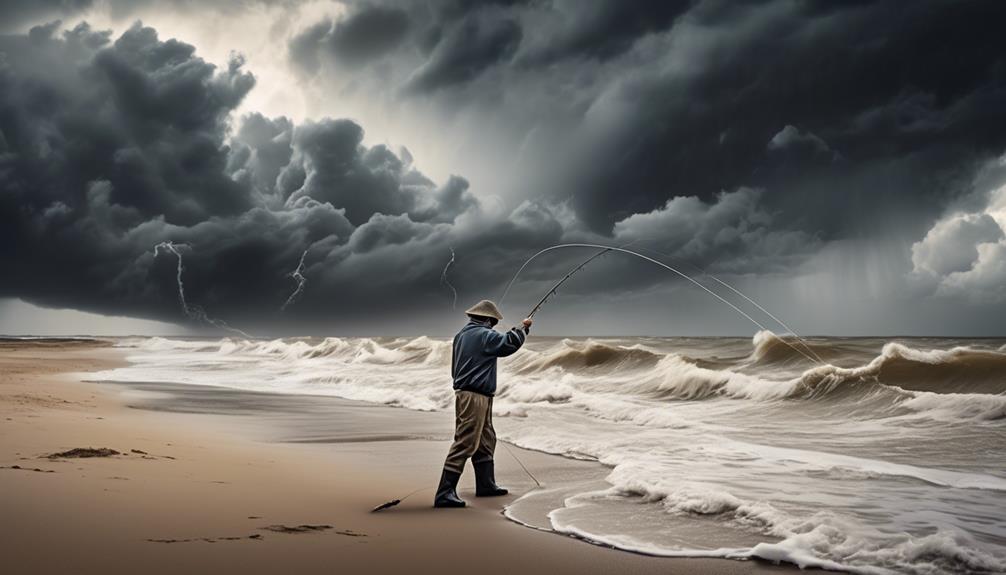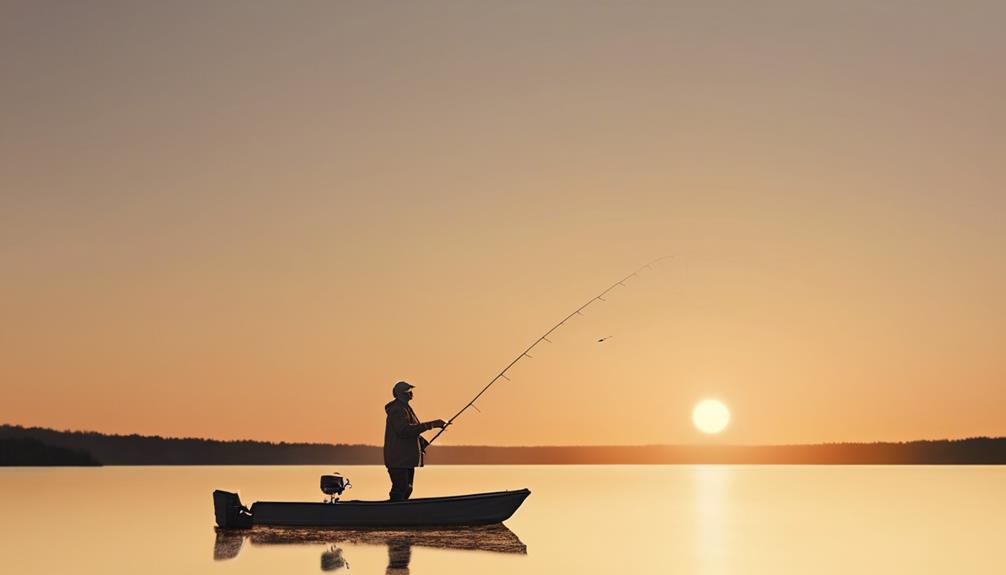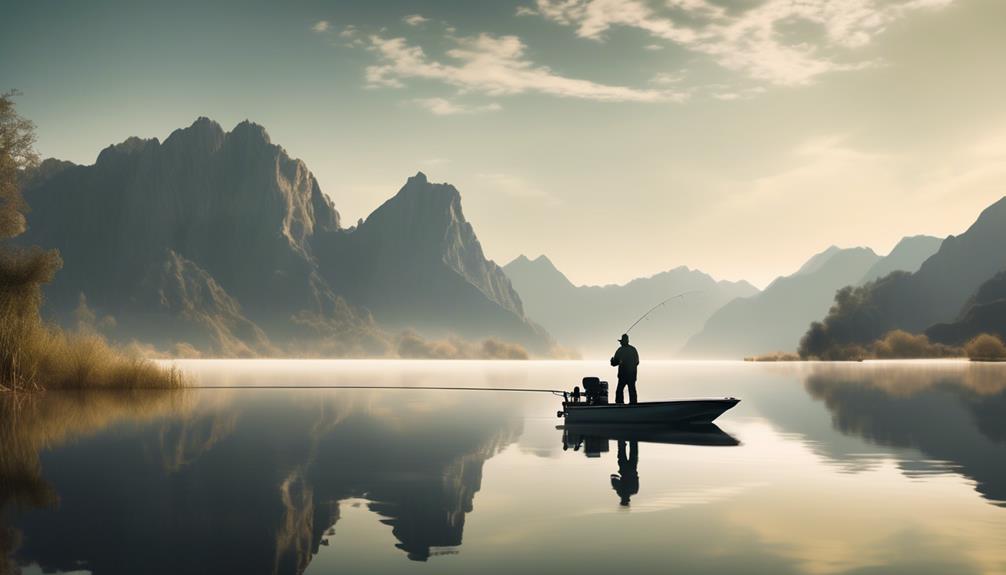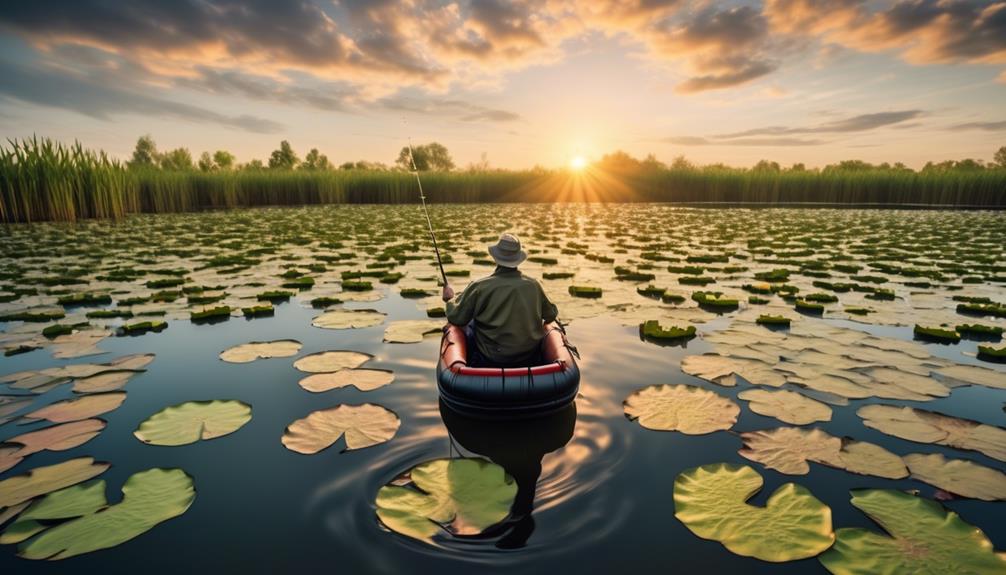Imagine the shoreline as a chessboard, with the redfish as the elusive king waiting to be captured. As you stand at the water's edge, poised and ready, you're faced with the challenge of outsmarting these cunning and powerful creatures.
You've heard of the legends surrounding successful redfish anglers, and you wonder what secrets they hold. Well, wonder no more. There are proven techniques and strategies that can help you unlock the mysteries of reeling in these prized fish.
So, how can you master the art of saltwater shore fishing for redfish?
Understanding Redfish Behavior
To effectively catch redfish while shore fishing, understanding their behavior is crucial. Redfish are highly sensitive to water temperature, as it directly impacts their predatory behavior. During the cooler months, redfish tend to move to shallower waters where the sun can warm the water more effectively. As the water temperature rises, they become more active and aggressive in their pursuit of prey. Understanding this behavior allows you to predict where the redfish are likely to be at different times of the year.
When the water temperature drops, redfish seek out warmer areas such as shallow flats, mud bottoms, or areas with dark, muddy bottoms that can absorb and retain heat from the sun. This behavior makes them more predictable and easier to locate.
On the other hand, during warmer months, they're more likely to be found in deeper waters and around structures like docks, piers, and oyster beds where they can find cooler temperatures and ambush their prey.
Selecting the Right Bait
Selecting the right bait plays a crucial role in enticing redfish to bite while shore fishing. To maximize your chances of a successful catch, consider the following tips:
- Bait Presentation: Redfish are known to be opportunistic feeders, and the way your bait moves in the water can greatly influence their decision to strike. When selecting bait, opt for those that can mimic the natural movements of the redfish's prey, such as shrimp, mullet, or small crabs. Utilizing live bait can also enhance the realism of the presentation, making it more appealing to redfish.
- Water Temperature: Understanding the water temperature is vital in selecting the right bait for redfish. These fish are sensitive to changes in water temperature, and their feeding behavior can be influenced by it. During warmer months, redfish tend to be more active and may prefer livelier baits. In contrast, during cooler periods, they may be more inclined to strike at slower-moving or suspended baits.
- Adaptability: Redfish can be quite selective when it comes to bait, so being adaptable in your approach is essential. It's important to carry a variety of bait options to cater to different conditions and scenarios. This adaptability may involve switching between live and artificial baits, adjusting the size of the bait to match the local forage, or experimenting with different presentation styles until you find what works best.
Mastering Casting Techniques
When mastering casting techniques for saltwater shore fishing, practice precision and control to effectively target redfish in varying water conditions. Distance casting is essential when you need to reach redfish feeding farther from the shore. To achieve greater distance, use a smooth, powerful casting motion, loading the rod with energy before releasing the line.
Remember to maintain accuracy even when casting far by aiming for specific spots where redfish are likely to be. Precision casting is crucial for targeting redfish in shallow waters or around structures. Practice making accurate casts to tight spots, such as around docks, mangroves, or submerged vegetation, where redfish often seek shelter and food. By honing your precision casting skills, you can place your bait or lure closer to these areas, increasing your chances of enticing a redfish to strike.
Controlling the distance and accuracy of your casts will greatly improve your success in catching redfish from the shore. Additionally, mastering different casting techniques, such as sidearm, overhead, and pitching casts, will give you the versatility to adapt to different fishing environments and conditions.
Regular practice and experimentation with different casting styles will help you become a more proficient angler, ready to tackle any saltwater shore fishing situation.
Utilizing Tides to Your Advantage
Consider the tidal movements and their impact on redfish behavior to strategically position yourself for better chances of a successful catch. Understanding tidal patterns is crucial when shore fishing for redfish. Here are three tips to help you make the most of the tides:
- Tidal Patterns: Pay close attention to the local tidal patterns. Redfish are known to move with the tides, often feeding more actively during incoming or outgoing tides. During high tide, they tend to move closer to the shore and into shallower waters, while low tide may see them retreating to deeper channels or oyster beds. By familiarizing yourself with the tidal patterns of the area, you can anticipate where the redfish are likely to be at different times, increasing your chances of a successful catch.
- Shoreline: When fishing for redfish from the shoreline, take note of how the tides affect the layout of the coastline. As the water level changes, it can reveal or conceal various structures such as sandbars, grass beds, or oyster beds. These areas are prime spots for redfish to forage for food. Position yourself strategically along the shoreline, adjusting your location as the tides ebb and flow to capitalize on the changing topography and the movements of the redfish.
- Angling Techniques: Tailor your angling techniques to the shifting tides. During high tide, casting closer to the shore or around structures like oyster beds may yield better results. As the tide recedes, consider casting towards deeper channels or areas where redfish might seek refuge. Adapting your approach based on the tidal movements can significantly improve your chances of enticing a redfish bite.
Choosing the Ideal Fishing Spots
To maximize your chances of a successful catch, identifying strategic locations along the shoreline is crucial when targeting redfish from the shore. When choosing the ideal fishing spots, consider the tide patterns and water depth to increase your chances of hooking a redfish.
Start by understanding the tide patterns in the area you plan to fish. Redfish are often found feeding in shallow waters during high tide, so look for spots with shallow flats or marshy areas that are covered during high tide. During low tide, redfish tend to move to deeper channels and holes, so focus your efforts on these areas when the tide is low.
Water depth is another crucial factor in choosing the right fishing spot. Redfish are known to frequent areas with varying water depths. Look for spots with a mix of shallow and deeper waters, such as drop-offs, sandbars, or channels. These areas provide redfish with access to both feeding grounds and refuge from predators.
Additionally, consider the presence of structures like docks, jetties, or submerged vegetation, as these provide cover and attract baitfish, which in turn attract redfish.
Handling Redfish With Care
Make sure to handle redfish with care to ensure their well-being and survival after being caught. Proper handling is crucial to minimizing stress and injury to the fish. Here are three important conservation practices to keep in mind when handling redfish:
- Use Barbedless Hooks: When fishing for redfish, opt for barbless hooks to minimize the damage to the fish. Barbless hooks are easier to remove, causing less harm to the fish's mouth and reducing the risk of injury during the hook removal process.
- Minimize Air Exposure: Redfish, like many other species, can experience negative effects from prolonged air exposure. Limiting the time a fish spends out of the water can significantly increase its chances of survival after being caught. Quickly and carefully handle the fish, and release it back into the water as soon as possible.
- Avoid Mishandling: Properly supporting the redfish is essential for its well-being. When handling the fish, make sure to support its body properly. Avoid putting excessive pressure on the gills or internal organs. Additionally, avoid dropping the fish onto hard surfaces or handling it roughly, as this can cause internal injuries or harm to its protective mucous layer.
Adapting to Weather Conditions

When fishing for redfish, it's important to adapt to weather conditions in order to maximize your chances of a successful catch. Weather preparation is crucial for a productive fishing trip. Keep an eye on the weather forecast before heading out. If there are strong winds predicted, consider choosing a more sheltered fishing spot to avoid struggling with casting and line control. On the other hand, if the weather is calm and the sun is shining, focus on shallow areas where redfish tend to feed during these conditions.
Adapting your fishing techniques based on weather conditions can significantly improve your chances of hooking redfish. During windy days, opt for heavier lures or sinkers to ensure your bait stays in the strike zone. Additionally, casting against the wind can help your bait cover more ground in the water. In contrast, on calm days, lighter lures and baits are more effective, as they'll mimic natural movements in the water. Adjust your retrieval speed to match the current weather conditions. For instance, in choppy waters, a faster retrieval can attract redfish by creating more commotion.
Monitoring and adapting to weather conditions is an essential aspect of successful saltwater shore fishing for redfish. By staying prepared and adjusting your fishing techniques accordingly, you can optimize your chances of a productive and enjoyable fishing experience.
Enhancing Your Fishing Gear
While adapting to weather conditions is crucial for a successful catch, you can enhance your fishing gear to further improve your chances of hooking redfish. Upgrading equipment and maintaining your gear are essential steps to ensure you're well-prepared for your saltwater shore fishing adventure.
Here are three ways you can enhance your fishing gear:
- Upgrade Your Reel: Consider investing in a high-quality saltwater spinning reel with a smooth drag system. Redfish are known for their powerful runs, and a reliable reel will help you handle their strength. Look for a reel with corrosion-resistant components to withstand the harsh saltwater environment.
- Maintain Your Rod: Regularly inspect your fishing rod for any signs of wear and tear, such as cracked guides or weakened joints. Clean your rod after each use to remove salt build-up and debris. Additionally, consider applying a protective coating to prevent corrosion.
- Sharpen Your Hooks: Sharp hooks are crucial for successfully hooking redfish. Use a hook sharpener to maintain a razor-sharp point. Inspect your hooks for any signs of rust and replace them if necessary. Keeping your hooks in top condition will increase your chances of a solid hookset.
Frequently Asked Questions
What Are Some Common Mistakes to Avoid When Fishing for Redfish From Shore?
When fishing for redfish from shore, common mistakes to avoid include improper bait selection and neglecting tackle maintenance. To improve your technique, focus on using the right bait and maintaining your tackle.
Are There Any Specific Time of Day or Season That Is Best for Shore Fishing for Redfish?
For the best time and season to shore fish for redfish, early morning and late afternoon are ideal. During the fall and spring, redfish are more active near shore. These times and seasons offer optimal conditions for catching redfish.
How Can I Effectively Locate Schools of Redfish From the Shore?
To effectively locate schools of redfish from the shore, first, scan the water for signs of activity, such as baitfish jumping or birds diving. Then, use the right tackle selection, like a popping cork or topwater lure, to attract them.
What Are Some Tips for Maintaining a Stealthy Approach While Shore Fishing for Redfish?
To maintain a stealthy approach while shore fishing for redfish, observe their behavior and movement patterns. Use effective bait to entice them and practice precise casting techniques. By staying quiet and being mindful of your surroundings, you can increase your chances of a successful catch.
How Can I Handle Strong Currents or Rough Surf When Fishing for Redfish From the Shore?
When handling strong currents or fishing in rough surf for redfish from the shore, position yourself strategically to minimize the impact of the waves. Use heavier sinkers and sturdy gear to maintain control and stability while casting and reeling in your catch.
Conclusion
Now that you have learned effective saltwater shore fishing techniques for redfish, it's time to put them into practice. Remember to observe redfish behavior, select the right bait, master your casting techniques, and utilize tides to your advantage.
Additionally, it's important to choose ideal fishing spots, handle redfish with care, adapt to weather conditions, and enhance your fishing gear.
By honing these skills and knowledge, you'll be well-equipped to have a successful and enjoyable redfish fishing experience.
Good luck and tight lines!



